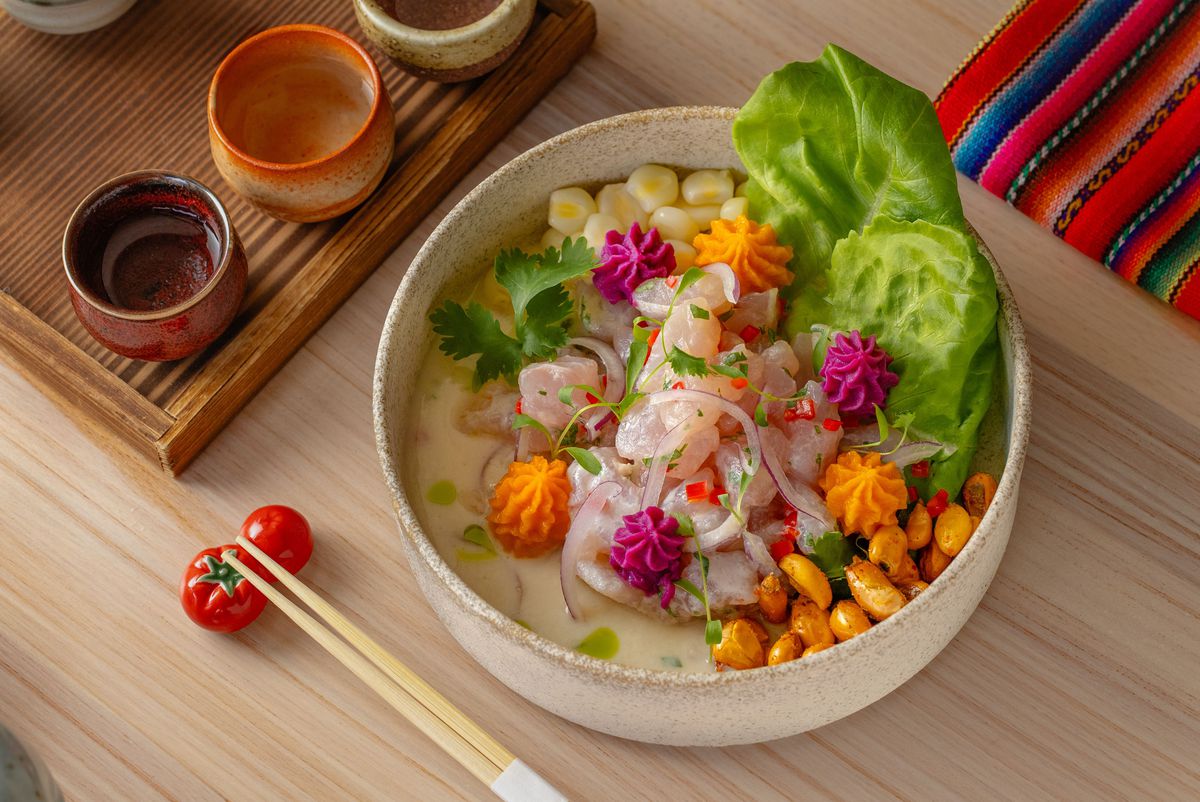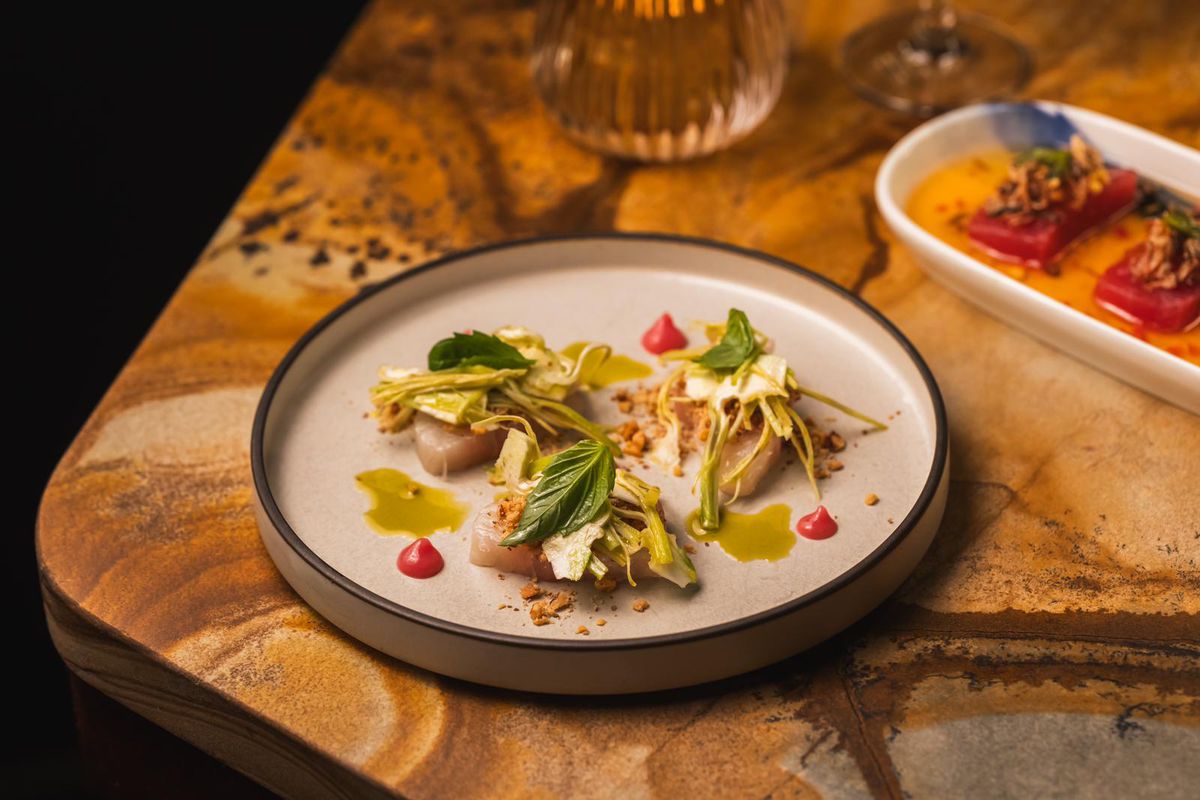If you’ve had seafood at a New York restaurant lately, chances are you’ve eaten something influenced by ike jime — even if you didn’t know it.
It starts with a method of killing fish quickly and precisely to preserve flavor, umami, and extend shelf life. That last part — longer shelf life — is what has helped kick off the dry-aged fish trend that’s popping up all over the city. While other aging techniques exist, ike jime preserves the purity of the fish without the added salt, spice, or smoke.
High-end sushi restaurants have been practicing ike jime for decades, with some Mexican, Peruvian, French, and Italian restaurants more recently following suit.
Ike jime was once a closely guarded secret passed from sushi masters to their protégés. Places like Morimoto and Masa have been doing it for years. Toshio Suzuki, a lauded pioneer of the now-closed Sushi Zen in 1984, was teaching ike jime at the French Culinary Institute in 2009.
As sushi protégés both here and around the world branched out, they took ike jime methods with them, writing books, launching websites, and teaching the technique in their own kitchens. Eventually, chefs outside the sushi world — like Alexandre Couillon in France and Josh Niland in Australia — got into it, too. And now in New York, ike jime is showing up everywhere, inspiring dishes beyond sushi. Here’s a look at a few restaurant dishes inspired by ike jime.
Plato marisquero at Corima
3 Allen Street, at Division Street, Chinatown
Fidel Caballero, chef-owner of Michelin-starred Corima, first learned about ike jime from a Japanese butchery book in 2014 — just as it was gaining popularity in Mexico. As he conducted research ahead of Corima’s 2024 opening, he came across King Kanpachi, the rare distributor selling ike jime fish outside of Japan: specifically, from Baja California Sur, Mexico.
The dish
Caballero has used kanpachi (yellowtail), in this case, part of the $125 tasting menu, in different ways: crudo with chicharron furikake, celtuce, and fermented husk cherry salsa; collars glazed with chintextle (smoked chile paste) and grilled over binchotan charcoal; and smoked and sliced for sashimi. The new spring menu features a seasonal plato marisquero: an assortment of shellfish, crustaceans, and the ike jime and dry-aged yellowtail, served sashimi-style.
55 Nassau Avenue, at Guernsey Street, Greenpoint
Chef Shuji Furukawa of Michelin-starred Restaurant Yuu doesn’t execute the technique himself, instead shipping the fish from Toyosu Market — which is standard practice for most NYC chefs. He’s played with perhaps the biggest variety of ike jime fish on his menu. But it’s a logistics game. “We calculate the timing of when the fish will be served on the plate and collaborate with the supplier to determine the optimal aging period,” he said.
The dish
With Spanish mackerel (sawara), which is part of a $300 tasting menu, he sears the skin, roasts the fish, and serves it with a yogurt bergamot sauce finished with chive-ponzu oil. For sakuradai (cherry sea bream) offered only in April and May, he ages it for three or four days, marinates it with kombu and sakura leaves, and serves it with a gelée of irizake (plum and sake reduction) and pinot noir. In the winter, he used barracuda.

Kansha
Fluke ceviche at Kansha
1312 Madison Avenue, at East 93rd, Upper East Side
At Kansha, a Peruvian-Japanese sushi restaurant in the Upper East Side, chef and owner Jorge Dionicio carries out ike jime himself. Through a 20-year resume that looks like a clout-diner’s bucket list, he’s learned to perfect it. He currently gets fluke flown in live from Japan.
“It’s hard to get bigger fish live,” Dionicio said. “Fluke is small and flat so it’s easier.”
Once it’s processed, every fish ages differently: It depends on the fattiness of the fish and the chef’s aging techniques. On a trip to Japan, Dionicio tasted a one-month aged tuna. “It was good, funky, completely different from regular tuna,” he said. “It’s really up to the chef how long it ages.”
The dish
At Kansha, he processes fluke ($26, or depending on the season, Japanese sea bass) as soon as he receives the shipment. Then he cures it whole, wrapped in kombu for up to two weeks. Finally, he makes ceviche with it. In his native Peru, “ceviche was about the flavor of the leche de tigre,” the pickling liquid of lime juice, onions, and chiles. “But I couldn’t find flavor in the fish. Now, the fish, even by itself, tastes good.”
“I hear a lot of my guests saying, ‘This is so fresh!’ And I’m laughing. That’s actually one or two weeks old,” said Dionicio. “The best fish isn’t the freshest fish.”
Steamed fish with black beans at JaBä
230 E. 58th Street, at Second Avenue, Midtown
Tony Inn, chef-owner of new modern Taiwanese spot, JaBä in Midtown East, feels lucky to have had Toshio Suzuki as his mentor. They first met in the early 2000s while he worked at Morimoto, whose eponymous chef and owner may perhaps be the most famous of Suzuki’s proteges. Inn later went to Masa, where Masayoshi Takayama flew in chefs from Japan to teach ike jime to his staff. In 2017, Inn linked back up with Suzuki at Sushi Zen. There, Suzuki had concocted his own ike jime tool: something like a basketball pump that he’d insert into the fish to blow air and water to clean out the blood.
Ahead of JaBä’s early May opening, Inn had ike jime fish on the menu: goby, a three-pound freshwater fish that he’d get shipped live from upstate and North Carolina. He planned to perform ike jime on eight to 12 fish every morning and leave them out for use that day. During friends-and-family service, he realized that he had to take it off the menu. “My walk-in [cooler] is at max capacity and my line is already jammed,” he said. “I can’t fit another steam item.” But it will eventually make it back onto the menu.
The dish
For Inn, ike jime is about maximizing texture. “You just can’t replicate it,” he said. To reinforce texture, he also plans to do the sukibiki technique. Instead of scaling a fish by scrubbing the scales away, he’d cut off a paper-thin layer of scales while maintaining a gelatinous membrane between scale and meat that would otherwise be damaged. With each order, he’d do a traditional Taiwanese preparation: steaming the whole fish, and seasoning it with fermented black beans, julienned ginger, and scallions — all drizzled with hot oil. Then he’d butterfly and debone the fish. “The whole point of me getting a live fish is to sell it that day, “ he said. “But, if I don’t sell it, I’m able to hold onto it for the next few days.”

Patrick Dolande/Alaluna
Hiramasa crudo and speck at Alaluna
453 Sixth Avenue, at West 11th Street, West Village
Chef Riccardo Orfino’s application of ike jime shows how far ike jime intel has traveled. The Milan-born chef learned about it from celebrated chef Jacopo Ticchi in Italy. When he opened Alaluna in the West Village last year, he homed in on ike jime for a competitive edge. “Having a neighboring restaurant already offering traditional fish dishes, it was important for us to find something different.”
The dish
Alaluna is the rare restaurant where customers can do a side-by-side comparison between different aging durations of ike jime hiramasa (yellowtail amberjack) from Japan. The younger crudo ($22) is soft and it breaks apart easily with each chew. For the hiramasa speck ($15), he brines the fish for six days, cures it in a spice rub for a week, smokes it, and then leaves it in his dry aging cabinet for 10 to 12 weeks.
Alaluna is closed for a couple months due to construction, so both dishes are currently offered at Travelers Poets & Friends.
Sign up for the
newsletter
Eater NY

